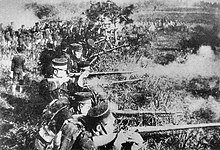First Sino-Japanese War
The First Sino-Japanese War (Chinese: 中日甲午戰爭, Japanese: 日清戦争; 1 August 1894–17 April 1895) was a war between the Qing dynasty and the Empire of Japan. Japan won the war and signed the Treaty of Shimonoseki with China in 1895.
| First Sino-Japanese War | |||||||||
|---|---|---|---|---|---|---|---|---|---|
 First Sino-Japanese War, major battles and troop movements | |||||||||
| |||||||||
| Belligerents | |||||||||
|
|
| ||||||||
| Commanders and leaders | |||||||||
|
|
| ||||||||
| Strength | |||||||||
|
630,000 men Beiyang Army Beiyang Navy |
240,000 men Imperial Japanese Army Imperial Japanese Navy | ||||||||
| Casualties and losses | |||||||||
| 35,000 dead or wounded |
1,132 dead, 3,973 wounded 11,894 died of disease | ||||||||
Comparison of military powers
change
|
Status of Chinese fleets
changeChina had 65 warships before the outbreak of the First Sino-Japanese War that were divided into four fleets (Beiyang Fleet, the Nanyang Fleet, the Guangdong Fleet and the Fujian Fleet). Only the Beiyang Fleet participated in the war. To save their ships, the other fleets' commanders did not join the war.
In the Beiyang Fleet, there were 25 warships. Dingyuan and Zhenyuan were the most powerful warships in the fleet and were made in Germany. Dingyuan had 6,000 horsepower and displaced 7,670 tons loaded. Nevertheless, as Empress Dowager Cixi wanted to build a grand garden, she embezzled the money originally that had been allocated for expanding the Beiyang Fleet. That meant that the commanders did not have enough money to buy the latest weapons for the fleet. Most of the warships in the fleet were not well equipped before the war.
Status of Japanese fleets
changeThere were 240,616 soldiers who could be mobilized in Japan before the outbreak of the war. Also, there were 32 battleships and 24 torpedo boats in the Imperial Japanese Navy. All of them had the latest and the newest weapons.
Main battles
change1. Battle of the Yalu River
On 17 September 1894, the Beiyang Fleet and the Imperial Japanese Navy fought at the Yalu River, the border between China and Korea. In this battle, the commander of the Beiyang Fleet was Ding Ruchang, originally a cavalryman, and Sukeyuki Ito was the commander of Japanese fleet. The battle lasted 5 hours. Finally, 4 battleships of the Beiyang Fleet was destroyed and 1,000 soldiers were killed. Only 1 battleship was lost in the Imperial Japanese Navy. The commander of the Beiyang Fleet retreated to the port of Lushun.
2. Battle of Lushunkou
On 17 September 1894, the Japanese armies occupied the fortresses with powerful cannons and cities in Lushun and Dalian. The Japanese troops entered the cities and killed 20,000 Chinese civilians within 4 days. This incident was historically called the Port Arthur massacre.
3. Battle of Weihaiwei
In January 1895, the Japanese armies invaded Weihaiwei. The Beiyang Fleet was fairly defeated, and 11 battleships of the team were seized.